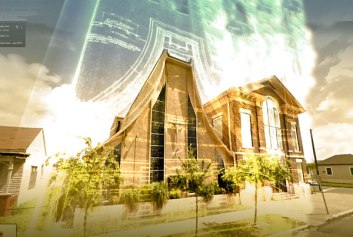Freeway-Free in Texas – Houston’s Julia Idelson Library – a Hidden Treasure

Some folks probably only visit’s Houston’s main library because you can get validated free parking in the library garage by making a visit to its downstairs lobby. They miss a lot.
On my recent trip, I was attracted by the garden and wrought iron fence surrounding the OLD library building (now known as the Julia Ideson Building, located right next to the new concrete edifice which supplanted it. )Once in the garden, I had to take a look at the historic building’s insides. And as often happens in old libraries (I am somewhat of a library junkie) I found hidden treasures.
In the downstairs lobby was an extensive exhibit of original letters and news articles in glass showcases, chronicling the struggle of Houston’s black population to gain entrance to the city’s libraries. It was fascinating and chilling to see how earnestly, politely, and stubbornly the black citizens of Houston staked their claim to equal access to the libraries their taxes helped pay for, and how circuitously, hypocritically, and stubbornly the city and the education system of 1920’s-40’s Houston resisted their claim. (Houston’s black populations did not have equal access to the libraries until the 1950’s, under pressure from returning black veterans and the Eisenhower administration.)
Upstairs we found a beautiful painted ceiling and plaster-relief fresco above the wood-paneled walls. Off one side of the vaulted second floor landing was a wonderful old reading room, presided over by Venus de Milo herself.
And behind an updated glass door was another exhibit, featuring the first black student to enroll in a major university in the South, John S. Chase. He was an architecture student, and there was no black college in Texas where the university system could pretend to offer him a “separate but equal” education. Despite many obstacles (e.g. Texas regulations had to be waived to allow him to get an architect’s license without having served an internship, as no architectural firm would hire him) Chase went on to become a successful architect and mentor to a generation of successors. 
On our way to the ladies’ room, we spotted a door at the end of the corridor marked “Authorized Researchers Only” . Of course we considered ourselves authorized researchers, and went in. Behind the oak doors was the original children’s room of the old library, with its age-darkened bookshelves crammed with the children’s books which were too old, too little in demand, too overtly racist, or for some other inscrutable reason were deemed unsuitable for general circulation in today’s Houston Library network. 
Of course, many of these books were very familiar to W and I and some had been much loved (Robert Lawson’s Smeller Martin and Elizabeth Coatsworth’s The White Horse were two I remember well and paged through once more with great glee, despite their racist stereotypes). It was an Ali Baba’s cave to booklovers.
If you are in Houston with some hours to while away (I’m thinking maybe a rainy day, of which there are many) this would be a wonderful way to while.










 My KF had secured a tape of the documentary “Voices of the Storm” – a Ken Burns -style documentary of the Great Storm of 1900 as told through letters and oral histories, illustrated by old photos and etchings. Every place has its history, every history has its stories to discover or imagine. I’m thinking – how to describe Galvestonians, this friendly group clinging to their barrier reef, restoring and rebuilding again and again? They might call themselves tenacious, loyal, deeply-rooted. I suspect their insurance agents might use a different set of adjectives – say… mulishly stubborn? Unable to learn from experience? Fighting a losing battle against Nature?
My KF had secured a tape of the documentary “Voices of the Storm” – a Ken Burns -style documentary of the Great Storm of 1900 as told through letters and oral histories, illustrated by old photos and etchings. Every place has its history, every history has its stories to discover or imagine. I’m thinking – how to describe Galvestonians, this friendly group clinging to their barrier reef, restoring and rebuilding again and again? They might call themselves tenacious, loyal, deeply-rooted. I suspect their insurance agents might use a different set of adjectives – say… mulishly stubborn? Unable to learn from experience? Fighting a losing battle against Nature?



